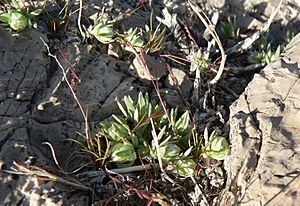Woollyhead neststraw facts for kids
Quick facts for kids Woollyhead neststraw |
|
|---|---|
 |
|
| Scientific classification | |
| Kingdom: | |
| (unranked): | |
| (unranked): | |
| (unranked): | |
| Order: | |
| Family: | |
| Tribe: |
Inuleae
|
| Genus: |
Stylocline
|
| Species: |
S. micropoides
|
| Binomial name | |
| Stylocline micropoides |
|
Stylocline micropoides is a small flowering plant. People often call it woollyhead neststraw, woollyhead fanbract, or desert neststraw. It's part of the aster family, which also includes daisies and sunflowers. This plant is special because it's covered in soft, white hairs, making it feel like wool or felt.
Contents
What is Woollyhead Neststraw?
Woollyhead neststraw is a type of annual herb. This means it grows from a seed, blooms, makes new seeds, and then dies, all within one year. It stays very close to the ground, with its stems usually growing up to 20 centimeters (about 8 inches) long.
Where Does It Grow?
This plant loves dry, sunny places. You can find it in the deserts and other dry areas of the southwestern United States. It also grows in the northern parts of Mexico. It's well-suited for tough desert conditions where not many plants can survive.
What Does It Look Like?
The Stylocline micropoides plant has a unique look because of its fuzzy texture.
- Stems: They spread out along the ground and are covered in white hairs.
- Leaves: The leaves are small, usually up to 2 centimeters (less than an inch) long. They are pointed and grow one after another along the stem.
- Flowers: The flowers grow in small, round bundles called flower heads. These heads are usually less than a centimeter across. They contain several tiny, woolly white flowers packed together. Sometimes, there are no special leaves (called phyllaries) around the flower head, or they fall off very quickly.
How Does It Survive in the Desert?
Living in the desert is tough because there's not much water. Woollyhead neststraw has adaptations that help it survive:
- Annual Life Cycle: By completing its life cycle in one year, it can grow quickly after a rain and produce seeds before the dry season returns.
- Hairy Coating: The white, woolly hairs on its stems and leaves help protect it. They can reflect sunlight, which keeps the plant cooler. They also help trap moisture, reducing how much water the plant loses to the dry air.
- Low Growth: Growing close to the ground can help the plant stay out of strong winds and find a bit more moisture in the soil.
Why Is It Called "Neststraw"?
The name "neststraw" likely comes from the way its woolly flower heads look. They might resemble small, soft nests, especially when they are full of the tiny white flowers. The "woollyhead" part of the name clearly refers to its fuzzy appearance.

